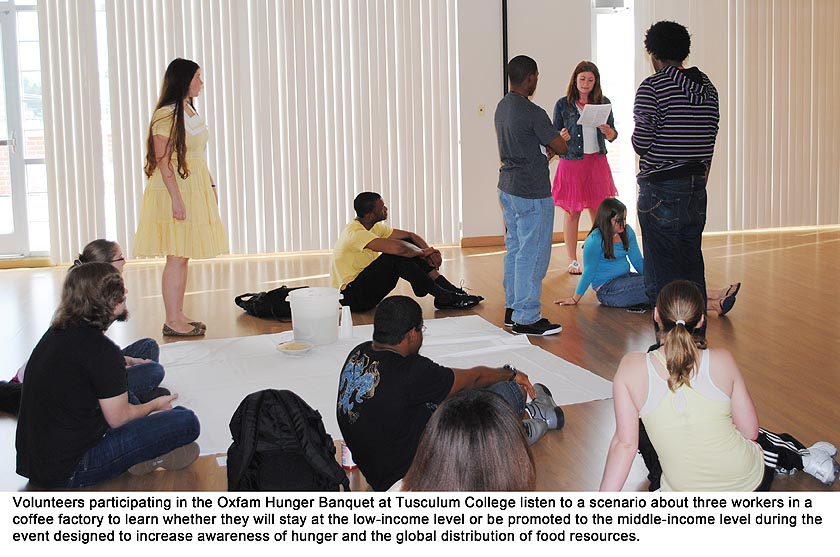A plastic bucket of water and a bowl of rice were waiting as dinner for a majority of the participants of the Oxfam Hunger Banquet Wednesday, March 23, at Tusculum College.
Representing the food resources of roughly half of the world’s population, the meager amount of food was shared by Tusculum students who sat on the floor and had no utensils to use other than plastic cups.
Coordinated by the Tusculum Bonner Leader student service organization, the Oxfam Hunger Banquet is designed to give participants, through their experience, an understanding of how the world’s food resources are distributed among the world population and some of the issues faced by people living at each level.
As they entered, each participant in the Hunger Banquet received a ticket that indicated in which economic group (low, middle, or high) he or she was assigned. The ticket also described the life of a specific individual in that economic group. Some tickets described two individuals, one in the economic group in a third world country and another one in the United States who had been helped by one of Oxfam’s programs to assist people in becoming self-sufficient.
Bonner Leader Kalie Smith served as the master of ceremonies, sharing statistics about each of the income groups. The majority of the students and staff who attended were in the low-income group, representing about 50 percent of the world’s population. Smith told the group about a widow in Ethiopia struggling to raise seven children, a family that typically eats one small meal a day.
A smaller group was designated as the middle-income group, representing about 35 percent of the world’s population. This group fared a bit better as they were able to sit on chairs for their meal of rice and beans. This group did have plastic forks and plates to use during their meal. Smith noted that this group often lives paycheck to paycheck and a loss of a job, a bad growing season or some other factor over which they usually have no control can result in dropping down into the low-income group.
Four people received “high-income” cards and were seated at a table set with silverware and glass tableware to be served a meal of pasta and salad. Smith noted that the high-income group represented about 15 percent of the world’s population, those earning $12,000 per year and up who can afford nutritious meals each day.
Smith also shared information from Oxfam about the causes of hunger, noting it is not an issue of a lack of food production but an unequal distribution of resources.
Participants were encouraged to learn more about hunger and its root causes, to share that information with others and to become involved with a group like Oxfam America that works to find solutions to poverty, hunger and injustice.
Oxfam America is a part of Oxfam International, a confederation of 14 Oxfams working in 98 countries. Together with individuals and local groups in these countries, Oxfam works to feed the hungry, help people overcome poverty and fight for social justice.



